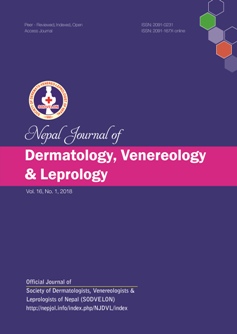Paraneoplastic Pemphigus Presenting as Toxic Epidermal Necrolysis: A Case Report
DOI:
https://doi.org/10.3126/njdvl.v16i1.19416Keywords:
Acantholysis, fluorescent antibody technique, direct, pemphigus, stevens-johnson syndromeAbstract
Polymorphous skin lesions have classically been described in paraneoplastic pemphigus (PNP), but it can present as toxic epidermal necrolysis (TEN) though this type of presentation is extremely rare. We report a case of PNP presenting as TEN in a young male patient. Patient had history of fever and diarrhoea six weeks before starting of lesions in oral cavity, for which he was treated with injectable medicines. Then patient developed generalized necrosis and peeling of skin with involvement of conjunctiva, oropharynx and genital mucosa. For this, the patient was given intravenous dexamethasone considering it as TEN, but after transient improvement initially skin lesions recurred when dose of dexamethasone was reduced. On seventh day, patient developed few circular deep ulcers over arms and back. Nikolsky sign was positive with tzanck smear showing acantholytic cells. Hence, we added PNP as one of the differential diagnosis. On further investigations patient was found to have B cell lymphoma in mediastinum and skin biopsy and direct immunofluorescence were confirmative of PNP. Unfortunately, patient then succumbed to death due to multiorgan failure and electrolyte imbalance. The onset of PNP can be as acute as TEN and clinical picture being initially undistinguishable, high index of suspicion is required in diagnosis.
Downloads
Downloads
Published
How to Cite
Issue
Section
License
Copyright on any research article is transferred in full to Nepal Journal of Dermatology, Venereology & Leprology upon publication. The copyright transfer includes the right to reproduce and distribute the article in any form of reproduction (printing, electronic media or any other form).




